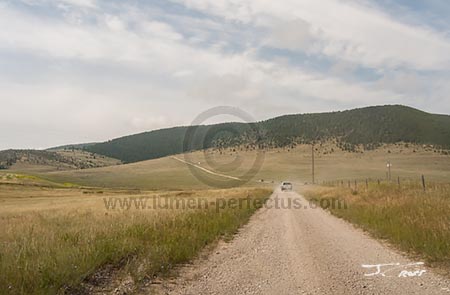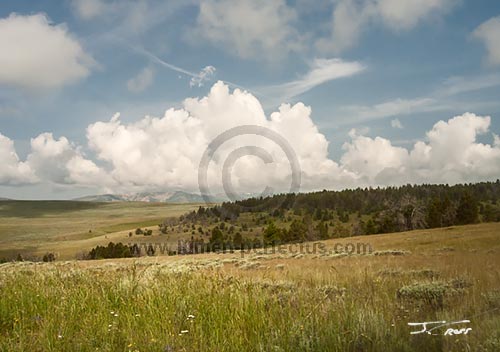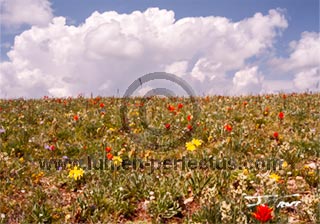www.lumen-perfectus.com
Spring in the Mountains
“Every spring is the only spring—a perpetual astonishment.”
Ellis Peters
Here in western Montana, “spring” is a flexible concept. Some years we transition from winter directly into summer; one day we'll have temperatures near freezing, with sleet or snow, the next day it'll be 90°F and the TV Weather Kid will drag out the annual report about rapidly melting mountain snow causing flooding in the valleys below. Some years winter will wind down gently as day-time temperatures warm gradually, snow in the valleys is largely gone by late April, beneficial rains fall in May and June (our wettest months), wildflowers are profuse, and everything is green. High-elevation snows melt slowly, feeding valley streams and rivers well into summer. These are the very best springs, but have been increasingly rare these last dozen years or so. Other years we'll have three feet of snow on the ground at Christmas, get another three feet by the middle of January, and then have no more snow until the next winter. 2015, being one of those years, gave us a cold, gray, precipitation-free spring that dragged on five months from that last snowfall until mid-May.
Much depends on elevation, of course. I live at 3700 feet (1130 m), so that's my “normal”, the reference by which I observe, measure, and complain about the weather. In the mountains spring often comes much later than in the valleys. In good years I can enjoy the return of migratory birds, the greening of the landscape, and the bloom of spring beauty, lupine, larkspur, wild rose, sticky geranium, fleabane, and much more here at home. Several weeks later I can do it all over again after gaining 3,000 to 4,000 feet or more on a hike into the mountains.
Montana's Gravelly Mountains

Gravelly Rainge Road (NF 290).
In July we camped at Lewis and Clark Caverns, a Montana State Park. We chose this location because it's near (40 miles, 65 km) Ennis, MT, where the US Forest Service has a field office. Several of the staff naturalists would be leading an all-day guided wildflower tour into the Gravelly Mountains. Could there be a better name for a mountain range than “Gravelly”? The Gravellys are interesting in that a road, the appropriately-named Gravelley Range Road (aka National Forest Service Road 290), goes through the range and over the top, allowing access to the higher elevations without a strenuous, mulit-day hike. The road is a rough, dusty two-track, best traveled in vehicles with several more inches of ground clearance than the typical commuter car. Much of the terrain is open, high-elevation meadow, many of which are leased for cattle grazing.
After a comfortable night in our little camper, and a few minutes packing a lunch, we headed for Ennis where we had breakfast and then found the Forest Service office.
An enthusiastic response to the advertising brought nearly 20 vehicles to the tiny field office. We began our drive a little after 9:00 AM. The elevation of Ennis is about 5000 feet (1524 m). From there we climbed steadily into the mountains; after nearly 30 miles (48 km), and an elevation gain of 2500 feet, we made our first stop.
Spring Flowers, in July?

A meadow at the first stop on a wildflower tour in the Gravelly Mountains.
These high mountain meadows are beautiful, expansive and green. After everyone parked we divided into a two groups. Each had two seasoned naturalists and an intern, and a 20-pound (9 kg) stack of plant identification books. Our guides were impressive in their knowledge, able to identify and describe the life cycle of every tree and flowering plant we found. On this first stop we found most of the flora under the trees and along the side of the road. Flowers were abundant but muted in color, mostly whites and pale yellows. Very pretty, but subtle, and just a teaser for what was to come. Surprisingly (to me, anyway), we found few invasive weeds. After about 40 minutes we moved on, driving another dozen miles to our next stop.
Here we found a poorly-maintained pit toilet and several picnic tables stashed in the woods. The sky had darkened, the temperature had dropped, and a light drizzle joined us as we ate lunch. The rain didn't last long. Neither did lunch, as we were eager to get into the expansive, flower-filled meadows beyond the trees. As before, we divided into groups, but they gradually merged into one; picture 30-odd wet people wandering a meadow, all bent over, looking down at their feet, often stopping and calling out to one of our ever-patient guides, “What's this?” Also as before, the flowers, while abundant, were soft and muted, without eye-popping color. As we meandered the meadow the clouds slowly parted, and in that transition between gloomy overcast and mostly clear we briefly experienced that magical fringe light; the air itself seemed to vibrate with a science-fiction glow one could almost hear. Given that most of us were looking at the ground, I think few people noticed that beautiful moment. Oddly, I didn't see any photo opportunities here, perhaps due to the lack of a distinct subject. If only a grizzly bear had wandered through that meadow….
A Final, Magnificent Stop

Wildflowers at Ruby Creek Overlook.
Moving on, we drove only another five miles or so to a spot our guides called Ruby Creek Overlook. The dark rain clouds had moved east, leaving us, at nearly three o'clock, in bright sunshine. A number in our group had turned around at the picnic stop, missing the best part of the tour. This overlook provides a wide rocky slope leading to cliffs and a dramatic drop down to Ruby Creek far below. Black Butte, an ancient cinder cone over 10,500 feet (3200 m) high, dominates the distant skyline. With all this stunning view offers, it's the flowers that steal the show. The rocky slope is covered with paintbrush and lupine. Although the flowers are densely packed, the loose, gravelly spaces between appear to have been churned up by nuclear-powered voles with carbide-tipped claws. One can only marvel at this amazing display of color in such a rocky, harsh place at 9400 feet (2865 m).
Given the nature of this tour, the large size of the group, and the late-morning-to-mid-afternoon timing of our stops, I didn't expect any great photography opportunities, and that expectation was handily met. Harsh afternoon sun collaborated with a strong breeze, the bane of outdoor flower photography, to minimize chances of making a quality, printable image. Still, I had to try, to at least make some digital captures and hope I could do something with them later in Photoshop. Shown here is the one photo I made with my DSLR and tripod, as a passing thin cloud slightly softened the hard light. The others above where made with a small point-n-shoot camera, hand-held.

Wildflowers at Ruby Creek Overlook, with Black Butte in the distance.
After an hour's exploration we turned around and headed back the way we'd come. The drive out was long, slow, dusty, and very bumpy. Thinking we'd save some time and get off the dusty two-track a bit sooner we turned onto Johnny Ridge Road (NF 324), and as shortcuts often seem to be, this one wasn't. NF 324 is twisty, rocky, often very narrow, and can't possibly be driven at more than 10 to 15 miles per hour unless one wishes an early death for their vehicle's suspension. To add to the adventure there's an unmarked Y in the road, with no sign to offer a clue as to the correct direction to turn. A little fiddling with the compass made it clear. If you find yourself in the Gravelly Mountains, take my advice and avoid NF 324!
We did, of course, eventually make our way out to US Highway 287, and then to Ennis, and finally back to the campground in time for a late dinner. Perhaps one day we'll make our way back into the Gravellys. An earlier start, and perhaps a different route to Ruby Creek Overlook could result in some outstanding photos.
A big thank-you to the staff of the Ennis Forest Service office. They've been running this tour for 18 years, with an eagerness and enthusiasm only those who love their jobs can maintain.
August, 2015
All products and brand names mentioned are trademarks or registered trademarks of their respective owners.